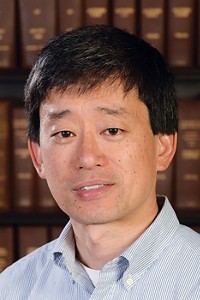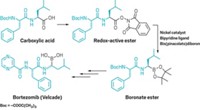Advertisement
Grab your lab coat. Let's get started
Welcome!
Welcome!
Create an account below to get 6 C&EN articles per month, receive newsletters and more - all free.
It seems this is your first time logging in online. Please enter the following information to continue.
As an ACS member you automatically get access to this site. All we need is few more details to create your reading experience.
Not you? Sign in with a different account.
Not you? Sign in with a different account.
ERROR 1
ERROR 1
ERROR 2
ERROR 2
ERROR 2
ERROR 2
ERROR 2
Password and Confirm password must match.
If you have an ACS member number, please enter it here so we can link this account to your membership. (optional)
ERROR 2
ACS values your privacy. By submitting your information, you are gaining access to C&EN and subscribing to our weekly newsletter. We use the information you provide to make your reading experience better, and we will never sell your data to third party members.
Synthesis
Elias J. Corey Award For Outstanding Original Contribution In Organic Synthesis By A Young Investigator
by Alex Scott
February 25, 2013
| A version of this story appeared in
Volume 91, Issue 8
Sponsored by the Pfizer Endowment Fund
Martin D. Burke, 37, has “introduced and commercialized the most powerful set of synthetic reagents for organic synthesis disclosed in the past five years,” according to Dale L. Boger, the Richard & Alice Cramer Professor of Chemistry at Skaggs Institute for Chemical Biology at Scripps Research Institute, in La Jolla, Calif. What’s more, Burke’s discoveries haven’t sat on a dusty shelf but have been rapidly used by research chemists in academia as well as those in industry.
In the work for which he is being honored, Burke exploited the unique stability and control of N-methyliminodiacetic acid (MIDA)-stabilized boronic acids in complex organic syntheses. His work behind the development of the reagents is “impeccable,” Boger says.
Burke, an associate professor of chemistry at the University of Illinois, Urbana-Champaign (UIUC), has succeeded in applying his MIDA boronate reagents to generate complex molecules. In recent applications, Burke has succeeded in synthesizing peridinin, parinaric acid, synechoxanthin, crocacin C, the polyene core of vacidin A, and a glucagon receptor inhibitor. In related work, Burke has determined the mechanism of action for amphotericin B, dissecting out key structural features required for the natural compound’s antifungal behavior, ion channel formation activity, and ergosterol-binding capability.
This selection of synthetic targets also has impressed Boger. “Their choice, based on unresolved fundamental questions at the chemistry-biology interface, represents the best I have seen among young chemists around the world,” he states.
Burke has discovered general methods for addressing the key challenges of storing and coupling unstable boronic acids as well as preparing structurally complex boronating building blocks in a highly stereocontrolled fashion.
Next on his agenda is to develop an automated platform for small-molecule synthesis. John A. Katzenellenbogen, a chemistry professor at UIUC, describes it as a small-molecule synthesizer machine that could ultimately bring the power of small-molecule synthesis to the nonchemist and thereby have a pervasive enabling impact throughout many fields of science, medicine, and engineering.
Burke has attracted more than 30 awards and honors since leaving John Hopkins University with a B.A. in chemistry in 1998. He earned a Ph.D. in chemistry in 2003 and an M.D. in 2005, both at Harvard University. Burke originally intended to do medical research but switched to chemistry because he became more interested in the idea of developing therapies for treating disease. He joined the UIUC faculty in 2005 as an assistant professor of chemistry and was promoted to his current position in 2011.
The prospect of developing—or enabling the rapid development of—small molecules for treating a host of diseases in humans is a task that excites Burke.
He concedes that he ruminates on chemistry problems before going to sleep and often finds himself picking up his BlackBerry and e-mailing himself ideas and solutions during the night. Sometimes it works, but the e-mails “don’t always make sense,” he says.
Problems that Burke is interested in solving involve the development of “molecular prosthetics,” in which diseases, such as cystic fibrosis, could be treated by replacing missing proteins with small-molecule surrogates.
Burke will present the award address before the ACS Division of Organic Chemistry.






Join the conversation
Contact the reporter
Submit a Letter to the Editor for publication
Engage with us on Twitter